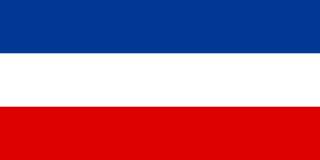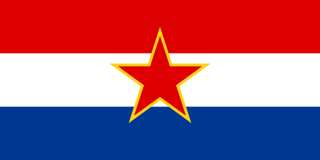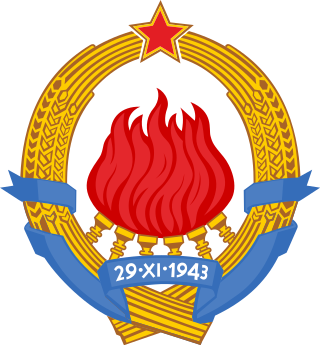
Serbia and Montenegro, known until 2003 as the Federal Republic of Yugoslavia, FR Yugoslavia or simply Yugoslavia, was a country in Southeast Europe located in the Balkans that existed from 1992 to 2006, following the breakup of the Socialist Federal Republic of Yugoslavia. The country bordered Hungary to the north, Romania to the northeast, Bulgaria to the southeast, North Macedonia to the south, Croatia and Bosnia and Herzegovina to the west, and Albania to the southwest. The state was founded on 27 April 1992 as a federation comprising the Republic of Serbia and the Republic of Montenegro. In February 2003, it was transformed from a federal republic to a political union until Montenegro seceded from the union in June 2006, leading to the full independence of both Serbia and Montenegro.

The Politics of Serbia and Montenegro, known as the Federal Republic of Yugoslavia, later renamed as Serbia and Montenegro, took place in a framework of a federal parliamentary republic with a multi-party system, and after 2003, in the context of a confederation. The president was head of state and, following constitutional reforms in 2003, simultaneously head of government. Executive power was exercised by the Council of Ministers. Federal legislative power was vested in the Serbia-Montenegro Parliament.

The Serb Democratic Party is a Serb political party in Bosnia and Herzegovina. Its current leader is Milan Miličević.
The Democratic Party of Socialists of Montenegro is a social-democratic and populist political party in Montenegro. A former long-time ruling party sitting at the opposition for the first time as of 2020, it was formed on 22 June 1991 as the successor of the League of Communists of Montenegro, which had governed Montenegro within the Socialist Federal Republic of Yugoslavia since World War II, and has remained a major force in the country ever since. The party is a member of the Socialist International and the Progressive Alliance, and an associate of the Party of European Socialists. During the 1990s, DPS was the major centre-left, social-democratic party in favour of Serbian-Montenegrin unionism. However, since 1997, the party has embraced Montenegrin independence and has been improving ties with the West, slowly turning into a catch-all party embracing Atlanticism, Montenegrin nationalism, neoliberalism, and pro-Europeanism.

The Parliament of Serbia and Montenegro was the legislative body of Serbia and Montenegro. The parliament was unicameral and was made up of 126 deputies, of which 91 were from Serbia and 35 were from Montenegro. The parliament was established in 1992 as the Federal Assembly of Yugoslavia as a direct replacement for Parliament of Yugoslavia and was renamed in 2003. With the declaration of independence of Montenegro on June 3, 2006, the parliament was dissolved.

The President of Serbia and Montenegro was the head of state of Serbia and Montenegro. From its establishment in 1992 until 2003, when the country was reconstituted as a confederacy via constitutional reform, the head of state was known as the President of the Federal Republic of Yugoslavia. With the constitutional reforms of 2003 and the merging of the offices of head of government and head of state, the full title of the president was President of Serbia and Montenegro and Chairman of the Council of Ministers of Serbia and Montenegro. In 2006 the office was abolished as the state union was dissolved, with Serbia and Montenegro becoming independent countries and was followed by Kosovo in 2008 although it received limited international recognition.
The European Montenegro was the ruling political alliance in Montenegro headed by Milo Đukanović's Democratic Party of Socialists (DPS).

The Socialist Republic of Croatia, commonly abbreviated as SR Croatia and referred to as simply Croatia, was a constituent republic and federated state of the Socialist Federal Republic of Yugoslavia. By its constitution, modern-day Croatia is its direct continuation.

The Socialist Republic of Serbia, previously known as the People's Republic of Serbia, commonly abbreviated as Republic of Serbia, was one of the six constituent republics of the Socialist Federal Republic of Yugoslavia in what is now the modern day states of Serbia and the disputed territory of Kosovo. Its formation was initiated in 1941, and achieved in 1944–1946, when it was established as a federated republic within Yugoslavia. In that form, it lasted until the constitutional reforms from 1990 to 1992, when it was reconstituted, as the Republic of Serbia within the Federal Republic of Yugoslavia. It was the largest constituent republic of Yugoslavia, in terms of population and territory. Its capital, Belgrade, was also the federal capital of Yugoslavia.

Dragoljub Mićunović is a Serbian politician and philosopher. As one of the founders of the Democratic Party, he served as its leader from 1990 to 1994, and as the president of the parliament of Serbia and Montenegro from 2000 to 2004.

The Republic of Serbia was a constituent state of the Federal Republic of Yugoslavia between 1992 and 2003 and the State Union of Serbia and Montenegro from 2003 to 2006. With Montenegro's secession from the union with Serbia in June 2006, both became sovereign states in their own right for the first time in nearly 88 years.

The Autonomous Province of Kosovo and Metohija, commonly known as Kosovo and abbreviated to Kosmet or KiM, is an autonomous province defined by the Constitution of Serbia that occupies the southernmost part of Serbia. The territory is the subject of an ongoing political and territorial dispute between Republic of Serbia and the partially recognised Republic of Kosovo. Its claimed administrative capital and largest city is Pristina.

The Parliament of Yugoslavia was the legislature of Yugoslavia. Before World War II in the Kingdom of Yugoslavia it was known as the National Assembly, while in the Socialist Federal Republic of Yugoslavia the name was changed to Federal Assembly. It functioned from 1920 to 1992 and resided in the building of the House of the National Assembly which subsequently served as the seat of the Parliament of Serbia and Montenegro and since 2006 hosts the National Assembly of Serbia.

Elections were held on municipal, provincial, republican and federal levels in Yugoslavia from its foundation in 1918 throughout its breakup in 1992.

Democratic Federal Yugoslavia was a charter member of the United Nations from its establishment in 1945 as the Socialist Federal Republic of Yugoslavia until 1992 during the Yugoslav Wars. During its existence the country played a prominent role in the promotion of multilateralism and narrowing of the Cold War divisions in which various UN bodies were perceived as important vehicles. Yugoslavia was elected a non-permanent member of the United Nations Security Council on multiple occasions in periods between 1950 and 1951, 1956, 1972–1973, and 1988–1989, which was in total 7 years of Yugoslav membership in the organization. The country was also one of 17 original members of the Special Committee on Decolonization.
Đorđe Đukić is a former politician in Serbia. He was the president of the executive council of Vojvodina from 2000 to 2004. He also served at different times in the Assembly of the Federal Republic of Yugoslavia, the National Assembly of Serbia, and the Assembly of Serbia and Montenegro, as well as being the mayor of Žabalj from 1996 to 2000. Originally a member of the Democratic Party, he joined the Liberal Democratic Party following a split in 2005 and later affiliated with the United Regions of Serbia.
Toplica Đorđević is a former politician in Serbia. He was a leading figure in the city government of Niš in the early 2000s, and has also served in the assemblies of Serbia, the Federal Republic of Yugoslavia, and the State Union of Serbia and Montenegro. During his time as an elected official, Đorđević was a member of the Democratic Party.
Ljubiša Jovašević is a Serbian medical doctor and politician. He was a parliamentarian in the Federal Republic of Yugoslavia and the successor State Union of Serbia and Montenegro from 2000 to 2006 and has served as the mayor of Kraljevo on two occasions. A member of the Democratic Party of Serbia for many years, he left the party in 2007 to form the Movement for Kraljevo. From 2010 to 2018, he was the de facto leader of the Movement of United Local Self-Governments.
Srđan Nikolić is a Serbian former politician. Between 2000 and 2008, he was a parliamentarian at the federal, republican, and provincial levels and served as the mayor of Ruma in Vojvodina. Nikolić was a member of the far-right Serbian Radical Party during his time as an elected official.










